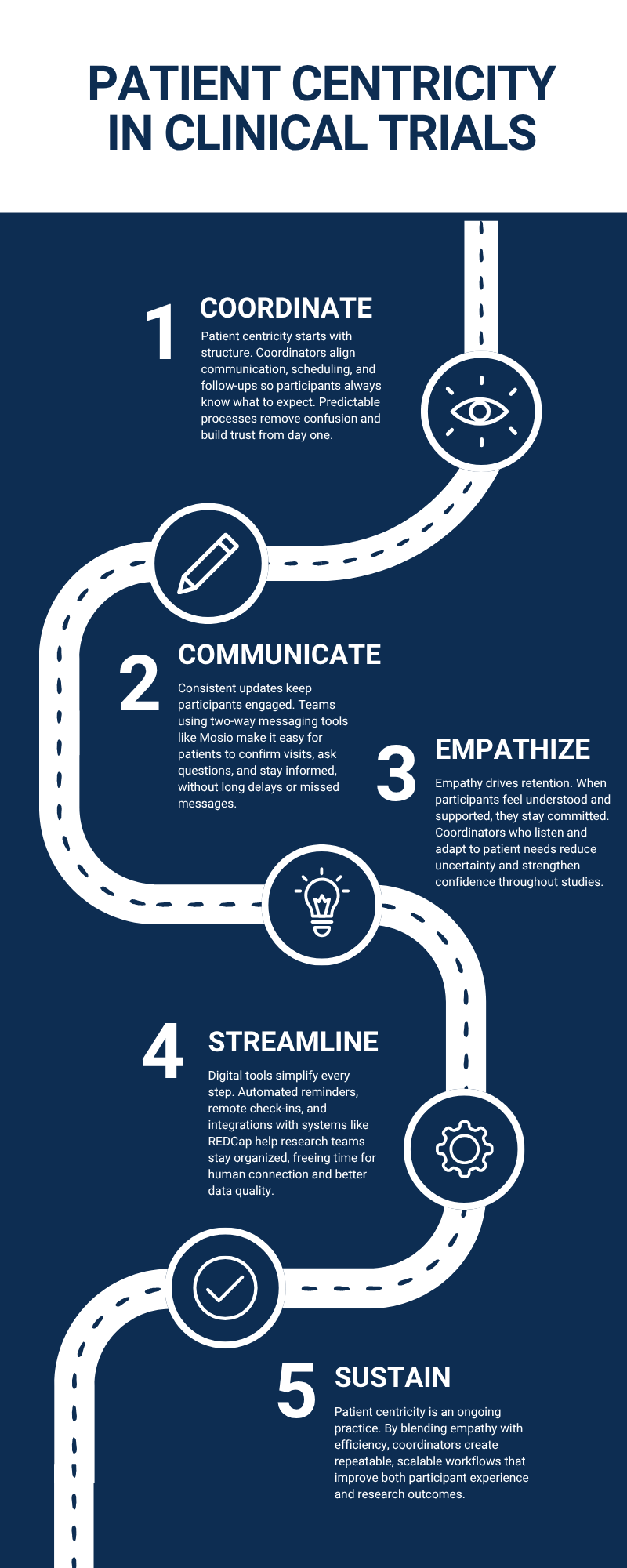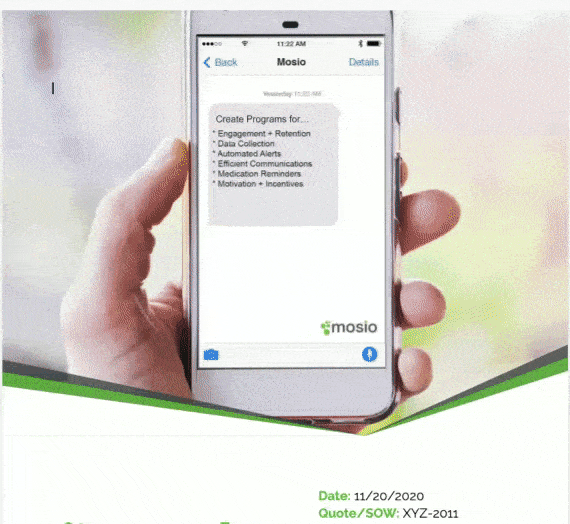Patient centricity in clinical trials is a defining part of modern research. Every conversation with coordinators shows that study success depends on more than protocols and endpoints. Participants shape how studies unfold in real time, and their experiences influence every outcome.
We know that patient centricity is only achieved with three key elements across every phase of a study:
- Coordination
- Consistency
- Empathy
What Does Patient Centricity In Clinical Trials Actually Mean Today?
Patient centricity means building research environments that adapt to participants. From what we’ve seen, when patients are no more than an afterthought, this results in poor patient retention and engagement.
Yes, we said it. Those dreaded words: poor patient retention and engagement.
We’ve covered this in several recent articles because our team knows just how detrimental disengaged patients are proving to clinical trials. With Mosio, our team is helping to make sure that clinical trial participation feels practical for patients. Through SMS, research teams using Mosio have built communication flows that respect participants’ time while maintaining urgency and compliance.
How Research Teams Address Participant Priorities
Coordinators noticed that retention improved when communication became predictable and organized. The shift began once technology made flexible communication possible. Automated systems have helped remove gaps in communication, which is making sure participants stay informed throughout studies.
We’ve seen coordinators restructure workflows to prioritize convenience. They have tested flexible scheduling, remote assessments, and digital follow-ups that match how participants want to communicate. With Mosio’s messaging tools, follow-ups became faster, simpler, and easier to manage for these teams.
Research teams tell us that this results in:
- Stronger data integrity
- More engaged and willing participants
- Fewer dropouts before the primary endpoint
Why Do Participants Drop Out Less In Patient-Centered Trials?
It’s simple, really: comfort builds commitment. What do we mean? Well, in a nutshell, participants who feel supported remain engaged. Teams are using text messaging, with Mosio’s platform, to set expectations at every stage of the study and reduce any uncertainty that could crop up. Coordinators who maintain steady communication establish confidence that keeps participants motivated to continue.
In our experience observing numerous studies, we’ve noted that trust always drives retention far more effectively than external incentives. This will support smoother data collection and fewer delays.
How Coordinators Practice Patient Centricity Day To Day
This is about consistent habits. Study teams practice patient centricity with:
- Brief check-ins
- Timely updates
- Milestone acknowledgments
You’ll find that each touchpoint shows attentiveness, which leads to better engagement and compliance.
Many research teams now use Mosio’s two-way text communication for reminders and updates. The format creates space for quick, compliant conversations. Participants confirm appointments, clarify details, or ask questions without any long waits.
Researchers tell us they notice shorter response times and far fewer scheduling conflicts when using text messaging to communicate with employees.
Digital tools form the structure that supports participant-centered work. REDCap captures organized data and Mosio connects communication to that process. This is why we encourage teams to first look at their technology stack when exploring ways to improve patient centricity in clinical trials.
Can Patient Centricity Take The Pressure Off Overstretched Teams?
In short, yes. It might sound like a contradiction, but it’s not. Patient centricity recognizes that empathy should extend to both participants and staff.
Workload pressure affects every team member involved in research. Clear, repeatable processes reduce stress on both sides. Mosio is just one example of how you can upgrade your technology stack to set some of these repeatable processes in motion.
All parties want study predictability. That’s the bottom line.
Mosio’s automation features can teams find that rhythm, which will establish repetitive, consistent communication with patients at every stage of a study.
Patient Centricity Will Give You A Competitive Edge
Sponsors recognize that participant experience influences every study metric. Recruitment costs fall when participants share positive experiences and retention strengthens through reliable coordination. Trials that prioritize participant comfort often reach completion more efficiently and produce higher-quality data.
Generally speaking, a patient-centered framework supports both operational and scientific goals with fewer disruptions. It builds lasting credibility with participants and regulators alike.
Start By Evaluating Your Clinical Trial Technology Stack
We believe patient centricity is the foundation of modern research operations. It’s really become a mindset for many of the teams we work with.
Expectations are increasing across the board for:
- Accessibility
- Responsiveness
- Personalization
Participants want clarity and coordinators need relief. Fortunately, technology connects both needs.
We know the next generation of clinical studies will be defined through empathy and precision working together. When communication tools like Mosio integrate with platforms like REDCap, studies become sustainable for both participants and coordinators.
The outcome is reliable science supported by stronger relationships. That is patient centricity in practice; and our team at Mosio is helping every research team make it possible.







